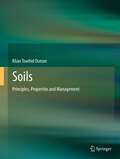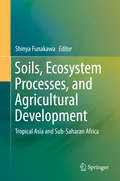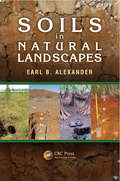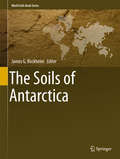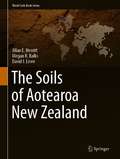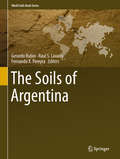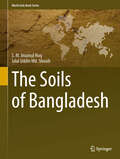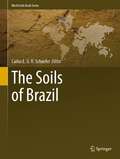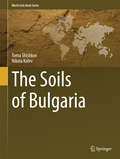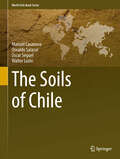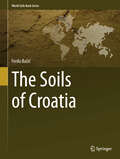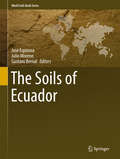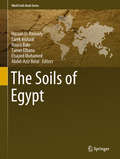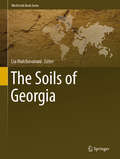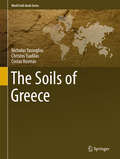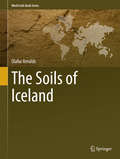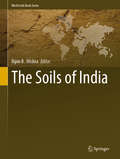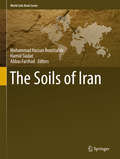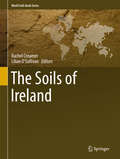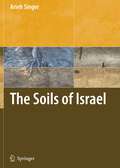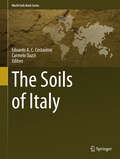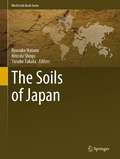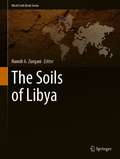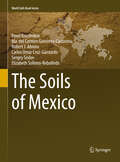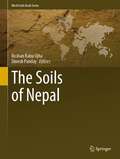- Table View
- List View
Soils: Principles, Properties and Management
by Khan Towhid OsmanAimed at taking the mystery out of soil science, Soils: Principles, Properties and Management is a text for undergraduate/graduate students who study soil as a natural resource. Written in a reader-friendly style, with a host of examples, figures and tables, the book leads the reader from the basics of soil science through to complex situations, covering such topics as:the origin, development and classification of soil physical, chemical and biological properties of soil water and nutrient management management of problem soils, wetland soils and forest soils soil degradation Further, the ecological and agrological functions of soil are emphasized in the context of food security, biodiversity and climate change. The interactions between the environment and soil management are highlighted. Soil is viewed as an ecosystem itself and as a part of larger terrestrial ecosystems.
Soils, Ecosystem Processes, and Agricultural Development: Tropical Asia and Sub-Saharan Africa
by Shinya FunakawaThe main objective of this book is to integrate environmental knowledge observed in local agriculture, based on the understanding of soils science and ecology, and to propose possible technical solutions and a more integrated approach to tropical agriculture. The chapters describe and analyze the ecological and technical countermeasures available for mitigating environmental degradation due to the increasing agricultural activities by humans, based on our scientific understanding of traditional agriculture in the tropics. This is an effective approach, as such ecological and technical tools previously involved in traditional activities are expected to be easily incorporated into present agricultural systems. The book starts with a rather classical pedological issue and analyzed traditional agricultural practices with different resource management strategies in terms of their modification of natural biological processes. It focuses on the present situation of tropical agriculture; that is, resource utilization in modern agriculture after application of technical innovation (increased application of chemical fertilizers as well as agricultural chemicals). Here, possible technical approaches to resource management that reasonably support agricultural production whilst mitigating environmental degradation are discussed. The negative impacts of agricultural development on our environment are rapidly growing, yet we are increasingly dependent on the agricultural sector for food and energy. The situation is similar in the tropics, where subsistence agriculture with low input management has long comprised most agricultural systems. Comparison of ecological and/or agronomical studies between different continents are still rare; therefore, this analysis may help clarify what is an essential problem when considering technical transportation beyond continents and/or between temperate and tropical regions.
Soils in Natural Landscapes
by Earl B. AlexanderIn any complete investigation of terrestrial ecosystems, rocks and soils must be considered. Soils are essential resources, providing water and nutrients for vascular plants, and mitigating the flow of water from the land. In addition, soil diversity is critical for biotic diversity. While there are many references on the agricultural perspective o
The Soils of Antarctica (World Soils Book Series)
by James G. BockheimThis book divides Antarctica into eight ice-free regions and provides information on the soils of each region. Soils have been studied in Antarctica for nearly 100 years. Although only 0.35% (45,000 km2) of Antarctica is ice-free, its weathered, unconsolidated material qualify as “soils”. Soils of Antarctica is richly illustrated with nearly 150 images and provisional maps are provided for several key ice-free areas.
The Soils of Aotearoa New Zealand (World Soils Book Series)
by Allan E. Hewitt Megan R. Balks David J. LoweThis book offers an introduction to the soils of Aotearoa New Zealand, structured according to the New Zealand soil classification system. Starting with an overview of the importance and distribution of New Zealand soils, it subsequently provides essential information on each of the 15 New Zealand soil orders in separate chapters. Each chapter, illustrated with diagrams and photographs in colour, includes a summary of the main features of the soils in the order, their genesis and relationships with landscapes, their key properties including examples of physical and chemical characteristics, and their classification, use, and management. The book then features a chapter on soils in the Ross Sea region of Antarctica and concludes by considering New Zealand soils in a global context, soil-formation pathways, and methods used in New Zealand to evaluate soils and assist in land-management decisions. Information about how to access detailed information via links to the Manaaki Whenua Landcare Research website is also included.
The Soils of Argentina (World Soils Book Series)
by Gerardo Rubio Raul S. Lavado Fernando X. PereyraThis is the first comprehensive book on Argentinian pedology. It discusses the main soil types of Argentina, their geographical distribution, classification, functions, agricultural use, ecological aspects, and the threats to which they have been subjected during centuries of intensive and extensive management. The description of the soils is accompanied by a complete set of data, pictures and maps, including benchmark profiles and an overview of the country's agricultural production. It also deals with future scenarios of the relationships between soil science and other disciplines and the main challenges that soil science will face in the future. Further, the book explores aspects of the main soil forming factors, such as climate, vegetation, geology and geomorphology, making use of new, unpublished data and elaborations, and presents a history of pedological research in Argentina.
The Soils of Bangladesh (World Soils Book Series #1)
by S.M. Imamul Huq Jalal Uddin ShoaibThis book presents a comprehensive overview of the soils of Bangladesh. It is compiled by authors with vast experience in soil related problems and potential mitigation approaches. It discusses the development of Soil Science as an individual discipline in a country with limited resources and where soil plays a pivotal role for the economy; the formation of different agro-climatic regions; and the effects of human-induced soil degradation and climatic change on its soils, geology and geomorphology and major soil types. It examines 'problem soils' and how they are managed, the scenario of soil fertility status, and land and crop management, as well as focusing on the future soils. Topics covered include: the history of soil research in Bangladesh; agro-climatic regions of Bangladesh; soil and climatic change, major soil types; soil maps; soil properties; soil classification; soil fertility; land use and vegetation; land use changes; human-induced soil degradation; soil contaminants; and future soil issues. This book will be a valuable resource for researchers and soil science professionals.
The Soils of Brazil (World Soils Book Series)
by Carlos E. G. R. SchaeferThis book represents the first comprehensive edition, in English, on the soils of Brazil, in the challenge of illustrating all the biomes of a country of truly continental dimension. In addition to presenting the first geosystemic view of Brazilian soils, in all geological, geomorphological and environmental aspects, the book also makes a key contribution to the discussion of current topics in Pedology, such as Anthrosols, Technosols, Soil Management trends and sustainability, Pedometrics and advanced techniques of digital soil mapping. The soils of Brazil were conveniently stratified into sectors and treated within the different biomes, without neglecting any area of the Brazilian territory. Considering the aspects of the landscape of occurrence, climates, geomorphology and geology, each pedological region was abundantly documented with soil profile data and many fine original, three-dimensional illustrations and diagrams, made with care by the authors. Among the regions, the most important are the forested Amazon, the Central Plateau with Cerrados, the Caatingas of the northeastern semi-arid region, the Atlantic Forest in all known variants; in addition, the Restingas, Mangroves, Oceanic Islands, Wetlands of the Pantanal and the subtropical regions of the Pampa and Matas de Araucaria. The book is of great importance as the first published work on Brazilian soils, but it is of great interest to geologists and geomorphologists who study the tropics and subtropics, due to the novelty and scope of the work.
The Soils of Bulgaria (World Soils Book Series)
by Toma Shishkov Nikola KolevThe Soils of Bulgaria offers a comprehensive analysis of the characteristics of soils and concepts on their magnitude. The purpose of the book is to introduce readers to the soil problematic and ecology in Bulgaria. The volume is divided into 3 parts. The first includes historical facts on soil research in Bulgaria, as well as general conditions and factors of soil formation, while the second applies an original pedological approach. The book’s third part focuses on essential information concerning land use/cover in Bulgaria. Each of the 13 chapters deals more specifically with fundamental chemical and physical soil properties, concepts of soil evolution, old and modern processes, geographic distribution, climatic conditions, topography, parent materials, plant associations, morphology and the relationship with different classification systems. The interactions between soil status and management are also highlighted. The use of the latest, statistically significant data ensures precise conclusions. The book also includes a large number of charts and new illustrations. The Soils of Bulgaria is crucial reading material for anyone interested in soil management and agriculture in Easter Europe, from students to policy makers and is also of particular interest for researchers in the field.
The Soils of Chile (World Soils Book Series)
by Manuel Casanova Osvaldo Salazar Oscar Seguel Walter LuzioThis book is intended for students and soil scientists who want to know about the state of the art in soil sciences in Chile. The book merges a comprehensive bibliographical review of the soil surveys carried out throughout the length and breadth of Chilean territory during the past 40 years and more recent information obtained by the authors in a number of field studies. As its starting point the book presents a general overview of important features related to Chilean soils, such as geology and geomorphology, climate, land use and vegetation. In this long and narrow country different soil formation factors and processes have resulted in a broad variety of soil bodies, from the extremely arid Atacama desert to the Patagonian and Antarctic zones. This book provides a description and classification (mainly Soil Taxonomy) of the most important soil types. Particularly important are soils derived from volcanic materials, which cover extensive areas of Chile. The book also deals with soil management topics in relation to the chemical, physical and biological properties of Chilean soils and it includes a number of examples from throughout the country. Finally, the book shows how man has induced severe soil degradation problems in Chile, such as erosive soil degradation, non-erosive soil degradation and land desertification.
The Soils of Croatia (World Soils Book Series)
by Ferdo BašićThe Soils of Croatia is a six-chapter book detailing all aspects of Croatian soils. The book presents, in a reader friendly way, the lively history of pedology in Croatia. It explains soils as natural resources for this country and offers a detailed view on the different agricultural regions referenced in Croatia. The Soils of Croatia also contains useful information regarding the different factors of soil genesis in the different regions as well as on soil taxonomy and it gives a very detailed classification of different Croatian Soils. Overall, this book contains everything that pedologists, students and anyone else interested in Croatian soils should know about.
The Soils of Ecuador (World Soils Book Series)
by José Espinosa Julio Moreno Gustavo BernalThis is the first book to comprehensively discuss Ecuadorian soils. Richly illustrated, it provides information on the unique characteristics and distribution of these soils. Due to the influence of the Andes, which vastly modified the climate and parental materials, a relative small country like Ecuador has a wide variety of soil orders, rarely found in other countries. The country is divided into three distinctive regions by the Andes: The Coastal Plain, the Andean Highlands, and the Amazonia Region each with different soil development, influenced by the varying conditions in that region.It is also necessary to consider the Galapagos Islands as a separate region with a particular climate and parental material.
The Soils of Egypt (World Soils Book Series)
by Hassan El-Ramady Tarek Alshaal Noura Bakr Tamer Elbana Elsayed Mohamed Abdel-Aziz BelalThis book reviews the distribution of soils across Egypt, their history, genesis, pollution and management. The conservation of Egyptian soils, soils and their connections to human activities, as well as some future soil issues are also highlighted. It is well known that soil is the main source for food, feed, fuel and fiber production. Accordingly, the study of soils is not only a crucial issue but also an urgent task for all nations worldwide. Due to their important roles in agroecosystems as well as many aspects of our lives, soils have direct and indirect functions in the agricultural, industrial and medicinal sectors. Therefore, understanding the physical, chemical and biological properties of soils, as well as soil security, have now become emerging issues. Climate change has a very dangerous dimension in Egypt concerning the rising sea level. Many coastal zones are already threatened by this sea level rise, and may ultimately disappear. At the same time, water shortages and soil pollution represent the main challenges for the Egyptian nation. Generally speaking, the environmental challenges that Egypt now faces include improving and sustaining soil health, soil carbon sequestration, wastewater treatment, and avoiding the overuse of fertilizers and pesticides. Therefore, this book examines in detail the soils of Egypt from various perspectives including their genesis, history, classification, pollution and degradation, soil security, soil fertility and land uses.
The Soils of Georgia (World Soils Book Series)
by Lia MatchavarianiThis book provides an extensive overview of the diversity of soils in Georgia. It highlights the soil-forming environment (climate, geology, geomorphology), the characterization of the physical, chemical and morphological (macro-, micro-) properties of soils, the history of soil research in Georgia, and the geographic distribution of different soil types. In addition to describing the soil cover, the book also zones and classifies the soils. Past and current land use issues, ecological properties and implications of soils, and many other aspects are elaborated on; special attention is paid to anthropogenic soil degradation due to the contamination and erosion of soils in Georgia. This comprehensive and richly illustrated book, which includes a wealth of pictures and soil maps, offers an essential field guide for soil scientists, geographers and researchers in related areas.
The Soils of Greece (World Soils Book Series)
by Nicholas Yassoglou Christos Tsadilas Costas KosmasThis book presents a comprehensive and up-to-date overview on soils of Greece. It includes sections on soil research history, climate, geology, geomorphology, major soil types, soil maps, soil properties, soil classification, soil fertility, land use and vegetation, soil management, soils and humans, soils and industry, future soil issues. The book summarizes what is known about the soils in Greece in a concise and highly reader-friendly way.
The Soils of Iceland (World Soils Book Series #9)
by Olafur ArnaldsIn this new volume in the World Soil series, the various types of Icelandic soils, their different characteristics, their formation, degradation and erosion are reviewed. At the same time, the book also deals with the agriculture and land use in general to give a complete view of Icelandic soils. The first part details the natural parameters such as the climate and the geography of Iceland. It also explains Icelandic geology, which is the major parameter controlling the soil formation in this country. The author describes the formation of Iceland, the main volcanic systems, central volcanoes, tephra production and its influence on the soils. Explanations on rocks, glaciers, rivers and other main geologic features are also given. The book continues with a description of the Icelandic geomorphology, giving insights on the main surface types, frost, cryoturbation and other cryogenic features. Then it details the different types of soils, their formation and main features, comparing the Icelandic soils to other soils elsewhere in the world. Erosion and land degradation are then reviewed, including the exceptionally active wind erosion and dust production. Finally, it gives an insight on land use, agriculture and vegetation types. All this accompanied by the most amazing photos to illustrate the great diversity of Icelandic Soil.
The Soils of India (World Soils Book Series)
by Bipin B. MishraThis book provides an overview of the diversified soil regimes in India. In addition to the historical advances in soil research and its limitations, it describes the monitoring of various soil conditions and soil uses to improve productivity. Discussing topics such as climate, geology and geomorphology, major soil types and their classification, soil mineralogy and clays, soil micromorphology, soil biogeochemistry, benchmark soils, land evaluation and land use planning, soil health and fertility and soil resilience, the book highlights the multiple uses of soils in industry, human health care, mitigation of challenges due to climate change and construction. It also presents measures for a brighter future of soil science in India, such as imposing organic farming principles toward sustainable agriculture in the context of the second green revolution besides alleviating the poverty and providing the employment opportunities among the farming communities in India.
The Soils of Iran (World Soils Book Series)
by Mohammad Hassan Roozitalab Hamid Siadat Abbas FarshadThis unique book addresses Iran’s extremely rich soil diversity and resources, which have developed under various climatic conditions ranging from dry to humid conditions. Featuring contributions by a group of respected experts on Iranian soils and agriculture, it provides comprehensive information on the management approaches needed for sustainable soil utilization and conservation under such conditions, and the attendant challenges. As such, it offers a valuable resource for anyone interested in soils and agriculture in Iran, but also in other Middle East and North African countries with similar climatic conditions. The book contains 14 chapters which illustrate the long history of indigenous knowledge and soil research, climate, geology and geomorphology, vegetation cover, soil forming factors and processes, major soils, properties and their classification. Furthermore, it presents past climate change and paleosols, agroecological zones, soil fertility, soil biology and biotechnology, human induced land degradation and “soil management in space and time”. In the end, major challenges facing the soil resources of the country are defined and recommendations are made to face the future challenges.
The Soils of Ireland (World Soils Book Series)
by Rachel Creamer Lilian O’SullivanThis book provides a comprehensive overview of pedology in Ireland. It describes the main soil types of the country, their functions, ecological use, and the conditions to which they were subjected associated with management over time. In addition, it presents a complete set of data, pictures and maps, including benchmark profiles. Factors involved in soil formation are also discussed, making use of new, unpublished data and elaborations. The book was produced with the support and sponsorship of Teagasc, The Agriculture and Food Development Authority, Ireland and the Irish Environmental Protection Agency.
The Soils of Israel
by Arieh SingerThis book describes the soils of Israel, offering details of their distribution, chemical, physical, and mineralogical characteristics and agricultural attributes. The pathways to the formation of each soil type are discussed against the background of such soil-forming factors as climate, lithology and physiography. The distribution of the different soil types is explained, based on the relationships between soils and soil-forming factors. This the first reference on the topic since 1948.
The Soils of Italy (World Soils Book Series)
by Edoardo A. C. Costantini and Carmelo DazziThe Soils of Italy is the first comprehensive book on Italian pedology in seventy years. Taking advantage of the authors’ large experience and of the most up-to-date information and technology, this book treats the main soil types of Italy, their diffusion, their functions, ecological use, and the threats to which they are subjected during centuries of intensive management. It also deals with future scenarios of the relationships between soil science and other disciplines, such as urban development, medicine, economics, sociology, and archaeology. The description of the soils is accompanied by a complete set of data, pictures and maps, including benchmark profiles. Factors of soil formation are also treated, making use of new, unpublished data and elaborations. The book also includes a history of pedological research in Italy, spanning over a century.
The Soils of Japan (World Soils Book Series)
by Ryusuke Hatano Hitoshi Shinjo Yusuke TakataThis book provides an overview of the distribution, properties, and function of soils in Japan. First, it offers general descriptions of the country’s climate, geology, geomorphology, and land use, the history of the Japanese soil classification system and characteristics and genesis of major soil types follow. For each region – a geographic/administrative region of the country – there is a chapter with details of current land use as well as properties and management challenges of major soils. Maps of soil distribution, pedon descriptions, profile images, and tables of properties are included throughout the text and appendices.
The Soils of Libya (World Soils Book Series)
by Hamdi A. ZurqaniThis book presents the soil pedodiversity in Libya. Soils are the source of all life; there can be no life without them. Further, each soil has its own history and its present conditions, which have been shaped by many different factors (e.g. climate, biota, parent material, and relief or topography). The book, divided into eight chapters, provides extensive information on Libyan soils. Chapter one provides an introduction and a broad perspective of the subject, while Chapter two covers the history of soil mapping and research in Libya. Chapter three focuses on local factors of soil formation and describes the geology and climate of the region to explain the diversity of its soils. Chapter four discusses soil classification systems and those most commonly used in the country. The fifth chapter illustrates the constraints and limiting factors that negatively affect agricultural activities across the country. The land cover/land use and the vegetation of the country are described in Chapter six. In turn, Chapter seven presents the status quo of soil biology, the corresponding related research activities, and the other biological properties of Libyan soils. The final chapter (Chapter eight) focus on land degradation and desertification in Libya, emphasizing the main causes, impacts of the phenomena, and efforts to combat it. This book demonstrates the problems that the country is currently facing as a result of climate change, soil erosion, salinization, and pollution, and outlines potential remedies to improve local food security. Bringing together the perspectives and expertise of many distinguished scientists from various universities and institutions in and outside of Libya, the book represents a unique and highly valuable resource.
The Soils of Mexico (World Soils Book Series)
by Pavel Krasilnikov Ma. del Gutiérrez-Castorena Robert J. Ahrens Carlos Omar Cruz-Gaistardo Sergey Sedov Elizabeth Solleiro-RebolledoMexico is an extensive country with an extremely complex mosaic of landscapes. The soils of Mexico have still not been completely studied, and there are few publications available on this subject. This book provides a state-of-the-art view on Mexican soils, their geographical distribution, their use and degradation. This is a first attempt to give a systematized characteristic of the soil resources of Mexico. Land resources of the second-biggest economy in Latin America are critical for its sustainable development, and a demand for adequate soil information is high. The information contained within can be used for any soil-related research done in Mexico and in neighboring countries. The book includes detailed characteristics of soils of all the physiographic regions of Mexico with maps, photos and explanatory schemes. The book is based on the experiences of the authors in research and soil survey, as well as on the existent, mainly ‘grey’ literature on Mexican soils. The book is recommended for researchers and university readers, students of all levels and decision-makers, working in the area of soil science, environmental issues, Earth sciences, land management and nature conservation.
The Soils of Nepal (World Soils Book Series)
by Roshan Babu Ojha Dinesh PandayThis book publishes consolidated information on the soils of Nepal from all possible sources. The Survey Department, Government of Nepal, conducted two national scale soil survey projects to classify soils of Nepal (Land Resource Mapping Project ended in 1985, and National Land Use Planning Project ended in 2021). Both projects adopted the United States Department of Agriculture system of soil classification. Besides, National Soil Science Research Center (previously known as Soil Science Division) of Nepal Agricultural Research Council and Soil Management Directorate, Department of Agriculture, also worked on soils of Nepal. To date, the information on the soils of Nepal is not published in well-documented form but has been reported widely as gray literature (project report or government report) or peer-review articles.'The Soils of Nepal’ is a part of ‘World Soils Book Series’ which constitutes twelve chapters—covering broad aspects such as soil research history, climate, geology, soil classification and mapping, and soil fertility. Furthermore, information about soil properties and relation between soil constituents of the dominant soil types of Nepal and their scope of use in the context of land use are described. This book also tries to simplify the intricate relationship among soil, culture, and people. Each chapter contains a comprehensive, richly illustrated, and up-to-date overview of the soils of Nepal. We believe it fulfils a quest for a global audience including students, educators, extension workers, and soil scientists, who are interested to know the young soils of Nepal.
